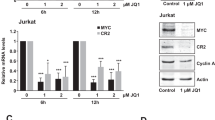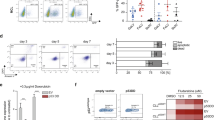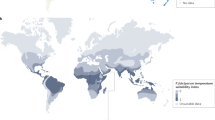Abstract
Epstein–Barr virus (EBV) is etiologically linked to endemic Burkitt lymphoma (BL), but its contribution to lymphomagenesis, versus that of the chromosomal translocation leading to c-myc gene deregulation, remains unclear. The virus's growth-transforming (Latency III) program of gene expression is extinguished in tumor cells, and only a single viral protein, the EBV nuclear antigen (EBNA)1, is expressed via the alternative Latency I program. It is not known if BL arises from a B-cell subset in which EBV naturally adopts a Latency I infection or if a clone with limited antigen expression has been selected from an EBV-transformed Latency III progenitor pool. Here we identify a subset of BL tumors in which the Latency III-associated EBNA promoter Wp is active and most EBNAs are expressed, but where a gene deletion has specifically abrogated the expression of EBNA2. This implies that BL can be selected from a Latency III progenitor and that the principal selection pressure is for downregulation of the c-Myc antagonist EBNA2.
This is a preview of subscription content, access via your institution
Access options
Subscribe to this journal
Receive 12 print issues and online access
$209.00 per year
only $17.42 per issue
Buy this article
- Purchase on SpringerLink
- Instant access to full article PDF
Prices may be subject to local taxes which are calculated during checkout






Similar content being viewed by others
References
Rickinson, A.B. & Kieff, E. in Fields Virology 4th edn., Vol. II (eds. Knipe, D.M. & Howley, P.M.) 2575–2627 (Lippincott, Williams & Raven, Philadelphia, 2001).
Rowe, M. et al. Differences in B cell growth phenotype reflect novel patterns of Epstein–Barr virus latent gene expression in Burkitt's lymphoma cells. EMBO J. 6, 2743–2751 (1987).
Sample, J. et al. Restricted Epstein–Barr virus protein expression in Burkitt lymphoma is due to a different Epstein–Barr nuclear antigen 1 transcriptional initiation site. Proc. Natl. Acad. Sci. USA 88, 6343–6347 (1991).
Schaefer, B.C., Woisetschlaeger, M., Strominger, J.L. & Speck, S.H. Exclusive expression of Epstein–Barr virus nuclear antigen 1 in Burkitt lymphoma arises from a third promoter, distinct from the promoters used in latently infected lymphocytes. Proc. Natl. Acad. Sci. USA 88, 6550–6554 (1991).
Schaefer, B.C., Strominger, J.L. & Speck, S.H. Redefining the Epstein–Barr virus-encoded nuclear antigen EBNA-1 gene promoter and transcription initiation site in group I Burkitt lymphoma cell lines. Proc. Natl. Acad. Sci. USA 92, 10565–10569 (1995).
Nonkwelo, C. et al. Transcription start sites downstream of the Epstein–Barr virus (EBV) Fp promoter in early-passage Burkitt lymphoma cells define a fourth promoter for expression of the EBV EBNA-1 protein. J. Virol. 70, 623–627 (1996).
Kieff, E. & Rickinson, A.B. in Fields Virology 4th edn., Vol. II (eds. Knipe, D.M. & Howley, P.M.) 2511–2573 (Lippincott, Williams & Raven, Philadelphia, 2001).
Young, L. et al. Expression of Epstein–Barr virus transformation-associated genes in tissues of patients with EBV lymphoproliferative disease. N. Engl. J. Med. 321, 1080–1085 (1989).
Woisetschlaeger, M. et al. Promoter switching in Epstein–Barr virus during the initial stages of infection of B lymphocytes. Proc. Natl. Acad. Sci. USA 87, 1725–1729 (1990).
Woisetschlaeger, M. et al. Role for the Epstein–Barr virus nuclear antigen 2 in viral promoter switching during initial stages of infection. Proc. Natl. Acad. Sci. USA 88, 3942–3946 (1991).
Sung, N.S., Kenney, S., Gutsch, D.E. & Pagano, J.S. EBNA2 transactivates a lymphoid-specific enhancer in the BamHI C promoter of Epstein–Barr virus. J. Virol. 65, 2164–2169 (1991).
Abbot, S.D. et al. Epstein–Barr virus nuclear antigen 2 induces expression of the virus-encoded latent membrane protein. J. Virol. 64, 2126–2134 (1990).
Fahraeus, R. et al. Epstein–Barr virus-encoded nuclear antigen 2 activates the viral latent membrane protein promoter by modulating the activity of a negative regulatory element. Proc. Natl. Acad. Sci. USA 87, 7390–7394 (1990).
Wang, F. et al. Epstein–Barr virus nuclear antigen 2 transactivates latent membrane protein LMP1. J. Virol. 64, 3407–3416 (1990).
Zimber-Strobl, U. et al. Epstein–Barr virus nuclear antigen 2 activates transcription of the terminal protein gene. J. Virol. 65, 415–423 (1991).
Kaiser, C. et al. The proto-oncogene c-myc is a direct target gene of Epstein–Barr virus nuclear antigen 2. J. Virol. 73, 4481–4484 (1999).
Gregory, C.D. et al. Identification of a subset of normal B cells with a Burkitt's lymphoma (BL)-like phenotype. J. Immunol. 139, 313–318 (1987).
Magrath, I. The pathogenesis of Burkitt's lymphoma. Adv. Cancer Res. 55, 133–270 (1990).
Babcock, G.J., Hochberg, D. & Thorley-Lawson, D.A. The expression pattern of Epstein–Barr virus latent genes in vivo is dependent upon the differentiation stage of the infected B cell. Immunity 13, 497–506 (2000).
Khanna, R. & Burrows, S.R. Role of cytotoxic T lymphocytes in Epstein–Barr virus-associated diseases. Annu. Rev. Microbiol. 54, 19–48 (2000).
Pajic, A. et al. Antagonistic effects of c-Myc and Epstein–Barr virus latent genes on the phenotype of human B cells. Int. J. Cancer 93, 810–816 (2001).
Finke, J. et al. Monoclonal and polyclonal antibodies against Epstein–Barr virus nuclear antigen 5 (EBNA-5) detect multiple protein species in Burkitt's lymphoma and lymphoblastoid cell lines. J. Virol. 61, 3870–3878 (1987).
Rowe, M. et al. Restoration of endogenous antigen processing in Burkitt's lymphoma cells by Epstein–Barr virus latent membrane protein-1: coordinate up-regulation of peptide transporters and HLA-class I antigen expression. Eur. J. Immunol. 25, 1374–1384 (1995).
Khanna, R., Burrows, S.R., Argaet, V. & Moss, D.J. Endoplasmic reticulum signal sequence facilitated transport of peptide epitopes restores immunogenicity of an antigen processing defective tumor cell line. Int. Immunol. 6, 639–645 (1994).
Bornkamm, G.W., Hudewentz, J., Freese, U.K. & Zimber, U. Deletion of the nontransforming Epstein–Barr virus strain P3HR-1 causes fusion of the large internal repeat to the DSL region. J. Virol. 43, 952–968 (1982).
Rabson, M., Gradoville, L., Heston, L. & Miller, G. Non-immortalizing P3J-HR-1 Epstein–Barr virus: a deletion mutant of its transforming parent, Jijoye. J. Virol. 44, 834–844 (1982).
Hinuma, Y. et al. Immunofluorescence and herpes-type virus particles in the P3HR-1 Burkitt lymphoma cell line. J. Virol. 1, 1045–1051 (1967).
Jones, M.D., Foster, L., Sheedy, T. & Griffin, B.E. The EB virus genome in Daudi Burkitt's lymphoma cells has a deletion similar to that observed in a non-transforming strain (P3HR-1) of the virus. EMBO J. 3, 813–821 (1984).
Parker, B.D. et al. Sequence and transcription of Raji Epstein–Barr virus DNA spanning the B95-8 deletion region. Virology 179, 339–346 (1990).
Kempkes, B. et al. B-cell proliferation and induction of early G1-regulating proteins by Epstein–Barr virus mutants conditional for EBNA2. EMBO J. 14, 88–96 (1995).
Yoo, L., Mooney, M., Puglielli, M.T. & Speck, S. B cell lines immortalised with an Epstein–Barr virus mutant lacking the Cp EBNA2 enhancer are biased toward utilisation of the oriP-proximal EBNA gene promoter Wp1. J. Virol. 71, 9134–9142 (1997).
Yoo, L. & Speck, S.H. Determining the role of the Epstein–Barr virus Cp EBNA2-dependent enhancer during the establishment of latency by using mutant and wild-type viruses recovered from cottontop marmoset lymphoblastoid cell lines. J. Virol. 74, 11115–11120 (2000).
Cesarman, E., Dalla-Favera, R., Bentley, D. & Groudine, M. Mutations in the first exon are associated with altered transcription of c-myc in Burkitt lymphoma. Science 238, 1272–1275 (1987).
Bhatia, K. et al. Point mutations in the c-Myc transactivation domain are common in Burkitt's lymphoma and mouse plasmacytomas. Nature Genet. 5, 56–61 (1993).
Goossens, T., Klein, U. & Kuppers, R. Frequent occurrence of deletions and duplications during somatic hypermutation: Implications for oncogene translocations and heavy chain disease. Proc. Natl. Acad. Sci. USA 95, 2463–2468 (1998).
Komano, J., Sugiura, M. & Takada, K. Epstein–Barr virus contributes to the malignant phenotype and to apoptosis resistance in Burkitt's lymphoma cell line Akata. J. Virol. 72, 9150–9156 (1998).
Ruf, I.K. et al. Epstein–Barr virus regulates c-Myc, apoptosis, and tumorigenicity in Burkitt lymphoma. Mol. Cell. Biol. 19, 1651–1660 (1999).
Polack, A. et al. c-myc activation renders proliferation of Epstein–Barr virus (EBV)-transformed cells independent of EBV nuclear antigen 2 and latent membrane protein 1. Proc. Natl. Acad. Sci. USA 93, 10411–10416 (1996).
Gavioli, R. et al. c-Myc overexpression activates alternative pathways for intracellular proteolysis in lymphoma cells. Nature Cell Biol. 3, 283–288 (2001).
Staege, M.S. et al. Myc overexpression imposes a nonimmunogenic phenotype on Epstein–Barr virus-infected B cells. Proc. Natl. Acad. Sci. USA 99, 4550–4555 (2002).
Kovalchuk, A.L. et al. Burkitt lymphoma in the mouse. J. Exp. Med. 192, 1183–1190 (2000).
Habeshaw, G. et al. Epstein–Barr virus nuclear antigen 1 sequences in endemic and sporadic Burkitt's lymphoma reflect virus strains prevalent in different geographic areas. J. Virol. 73, 965–975 (1999).
Rooney, C.M. et al. Endemic Burkitt's lymphoma: phenotypic analysis of tumor biopsy cells and of derived tumor cell lines. J. Natl. Cancer Inst. 77, 681–687 (1986).
Tierney, R.J., Steven, N., Young, L.S. & Rickinson, A.B. Epstein–Barr virus latency in blood mononuclear cells—analysis of viral gene-transcription during primary infection and in the carrier state. J. Virol. 68, 7374–7385 (1994).
Lalvani, A. et al. Rapid effector function in CD8+ memory T cells. J. Exp. Med. 186, 859–865 (1997).
Acknowledgements
We thank A. Leese for performing the Elispot assays; D. Croom-Carter for assistance with immunoblotting and D. Morton for tumor biopsies and matching blood samples. This work was supported by Cancer Research UK and by a Cancer Research UK-funded studentship to G.K.
Author information
Authors and Affiliations
Corresponding author
Ethics declarations
Competing interests
The authors declare no competing financial interests.
Rights and permissions
About this article
Cite this article
Kelly, G., Bell, A. & Rickinson, A. Epstein–Barr virus–associated Burkitt lymphomagenesis selects for downregulation of the nuclear antigen EBNA2. Nat Med 8, 1098–1104 (2002). https://doi.org/10.1038/nm758
Received:
Accepted:
Published:
Issue Date:
DOI: https://doi.org/10.1038/nm758



